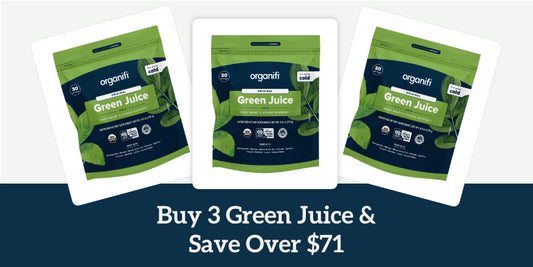Finding sunspots on face, hands, arms or legs is not a fun experience. No matter the age, we all want to look good. And sunspots tend to get in the way of that!
Like so many other areas of our lives, the key to healthy and radiant-looking skin is not just in what you put on it, but in what you eat. Nutrition can be a huge help when you want to slow down the signs of aging and feel the best version of you yet.
Mastering timeless skin care can feel a lot like finding a needle in a haystack, but one thing's for sure, those sunspots don't have a place on your face. So we put together all the info we could on sunspots and how to get rid of them from the inside out.
First, it's important to know that sunspots on your face are relatively normal and that there’s nothing wrong with aging like a fine wine, but there are steps you can take to remove them and prevent new ones from popping up - naturally!
What are Sunspots?
Sunspots are a defense mechanism of the skin, when you’re exposed to those UV rays the skin tries to protect itself from the harm and sends melanocytes to the exposed area in large numbers - that’s how we get tans and sunburns!
Sunspots on the face, hands, back, legs, and shoulders are common skin conditions that occur naturally on people with light to fair skin when exposed to -or over-exposed to - the UV rays of the sun.
When the skin is exposed to the sun it produces melanin to protect the area, when too much melanin is produced the skin gets those dark sunspots.
These marks, also called liver spots and solar lentigines, have a flat circle or oval appearance with smooth edges that contrasts in color with the skin surrounding it; you can often see them as large or medium size brown, tan, or colored specks.
They’re larger in size than freckles and it’s good to observe them for color, texture, and shape, since any change in their appearance may be a sign of something more dangerous than sunlight.
Real sunspots on your face or skin are harmless but may be treated for cosmetic purposes. Irregular or changing sunspots may be carcinogenic and must be treated immediately to avoid spreading. So, make sure you keep an eye on any sunspot on yourself or your loved ones.
What Causes Sunspots on Your Face?
When you’re interested in graceful aging, your timeless skin care routine may focus heavily on the face and its protection. However, you may find sunspots on your face even if you use sunblock regularly. Why? Because they come from hyperpigmentation or excess melanin, and this may happen due to:
-
Hormonal Changes: when the melanocyte stimulating hormone (MSH) is thrown out of balance due to pregnancy, birth control use, or other factors mostly in women.
-
Aging: the slow decay of the skin and organs happens mostly due to oxidative stress, caused by free radicals and the body’s natural antioxidant depletion. Getting more antioxidants in your diet helps reduce or slow down this process.
-
Chronic Inflammation: UV radiation can cause inflammatory reactions in the skin, if there are pre-existing inflammatory causes the reaction and oxidative damage is greater, creating melatonin clusters that appear as sunspots on your face, hands, arms, legs, and other areas.
-
Genetic predisposition: some DNA markers may result in a hereditary predisposition to sunspots on the face and other body parts, which are often found after the age of 40, but may appear earlier in people with such predisposition. Race and gender may also play a role in this proclivity.
-
Melasma: a process where hyperpigmentation of the skin occurs when exposed to sunlight. This condition is more frequent in women than men, and more often in darker skin types.
- UVB Ray Exposure: both from tanning beds and the sun. The skin reacts to UV rays with protective surges of melanin that are not equally dispersed after the “threat” passed.
Are Sunspots Connected to the Liver?
No, they are not. This common misconception arises from the name “liver spots,” but there is no evidence that sunspots on your face or any other body part are connected to liver function. If you’re concerned with unhealthy liver function symptoms, please take a look at our extensive resources on ways to detox your liver. But know that sunspots aren't the reason why you should do a liver detox!
Timeless Skin Care: Melanin and Sunspots
As you can see, there’s more to sunspots than just sunlight. The real culprit is melanin, the pigment that gives skin its natural color, tans, and red burns. Melanin protects the body from dangerous radiation by neutralizing free radicals from UV rays.
The more UV rays you’re exposed to, the more melanin your body produces, and the darker the skin or “sunspots” can become.
You may notice the ones that show up on your face, hands, and/or shoulders to be slightly darker than the ones found on legs, back, or arms. This is because the hands and face are more readily exposed to the light. Sun block helps, but you need to support it with skin-friendly nutrition.
Why Is Collagen Good for Sunspots?
Collagen the most abundant protein in your body and the fundamental block for healthy skin, nails, and hair, is one of the most natural ways to lighten and lessen the appearance of sunspots on your face and body. You may have already heard a lot about the benefits of collagen - especially when it comes to getting timeless skin.
But you may not know the how or why.
Collagen contributes to skin elasticity, firmness and the removal and replacement of dead skin cells - like melanin clusters. It’s one of nature’s most powerful tools for timeless skin care, but it’s not very abundant in the human body after the age of 30; its production starts to naturally decline at this time.
Multiple studies show that oral administration of collagen improves the look of sun-exposed skin, increases elasticity and moisture, reduces the severity of wrinkles, enhances overall skin health, and reverses sunspots.
The research found that collagen reduces the signs of melasma in women and of sunspots as well.
As you can see there are many answers to the “what is collagen good for?” question, but, in a nutshell, it’s your skin, hair, and nails' best ally.
Hydrolyzed collagen supplements raise the levels of collagen in the body, making the collagen molecules smaller and easier to process and send to the skin. This is important because as we age we produce less natural collagen and take longer to metabolize it.
Melanin is a photoprotective pigment that interacts with the matrix created by collagen to keep the skin safe from free radical damage. Together they work to eliminate and disperse the dark clusters (sunspots) that are no longer needed on the skin.
Get More Collagen in Your Diet:
Collagen is present in bones, ligaments, skin, hair, tendons, organs, blood vessels, and even the intestinal lining. There is no low-collagen measure, but the generation of sunspots on your face, achy joints, wrinkles, brittle nails, and stiffer body may all be signs that you need a collagen boost.
Here are some foods and ingredients that can help prevent sunspots and other unwanted consequences:
- Bone broth
- Lean meats like chicken and fish
- Eggs
- Citrus fruits
- Berries
- Guava
- Kale, Swiss Chard, and Chlorella
- Beans
- Cashews
- Tomatoes
Prevent Future Damage:
If you’re fighting those pesky sunspots on your face and body, increasing your collagen production is a great start, but it works even better when combined with these healthy habits:
- Support your body’s natural UV protection by avoiding direct UV ray exposure in tanning beds or the sun.
- Use sun block and eat foods that stimulate natural collagen production (like those we listed above).
- Take a collagen supplement to help reduce and prevent sunspots on your face and body, food alone might not do it.
- Eat and drink antioxidant-rich foods to help neutralize free radicals.
- Get more Vitamin E and C in your diet, as they both support healthy skin.
- Hydrate your skin with aloe vera for natural and timeless skin care.
- Try applying raw honey to the sunspots on your face, it may have a fading effect on existing marks.
- Use lactic-acid-rich buttermilk to gently lighten sunspots on your face and other visible places on your body.
Keep Your Skin Radiant:
Combining nutrition with skin protection is the best way to keep your skin looking younger and more radiant. Collagen is good for many things - like helping your body recover from sunspot damage on your face. Lather up on that sunscreen and sip our tasty pink lemonade Collagen supplement to GLOW this year.
If you try a collagen supplement to support your skin care routine, please let us know how it went. We can’t wait to hear your results.
After all, we’re in this together!




